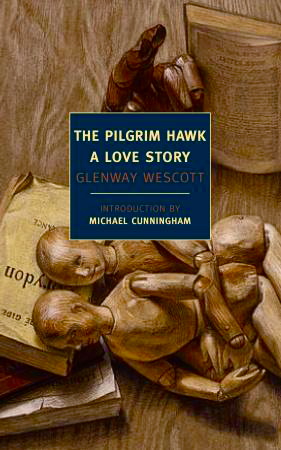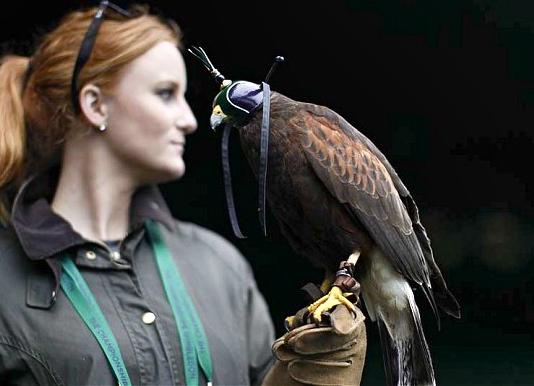Upon holding Lucy, the pilgrim hawk, for the first time, Alwyn Tower declares that “I felt rather as if I had a great thought of death concentrated and embodied and perched on me. Whatever had possessed me, I wondered to think of this Lucy – bloodthirsty brute with a face like a gouge, feet like two sets of dirty scalpels – as significant of love? Perhaps those two things, imaginary death and hopeless desire, always lie close together in one’s mind, foolishly interchangeable.”
 For those who have read the recent prizewinner H is for Hawk by Helen MacDonald, the powerful, genre-bending memoir of the author’s decision to tame and train a fierce goshawk as a way to deal with her grief following her father’s death, this novel by Glenway Wescott (1901 – 1987) may feel more civilized and stylistically much tamer. This is by no means a criticism of this marvelous book. The Pilgrim Hawk, a thoughtful, often symbolic novel, deals with much more than a woman’s relationship with a wild hawk and the agonizing search for herself which we see with the Helen MacDonald book. The pilgrim hawk here serves instead as the impetus to the action, and she is only one of several “characters” who participate in a broad examination of love and passion, and love’s closely related effects involving pain, pettiness, anger, self-doubt, and, in an ideal world, forgiveness. Ultimately, The Pilgrim Hawk considers the grandest theme of all – the relationship of love to personal freedom and whether it is possible to have one without the other, a theme for which the hawk becomes a foil. Regarded by critics as one of the best short novels of the twentieth century, The Pilgrim Hawk has been compared to William Faulkner’s The Bear in its importance, though the foreign setting, the well-to-do American characters, and the visiting Irish gentry mitigate the raw realities of Faulkner’s masterpiece in favor of a more mannered, more continental approach.
For those who have read the recent prizewinner H is for Hawk by Helen MacDonald, the powerful, genre-bending memoir of the author’s decision to tame and train a fierce goshawk as a way to deal with her grief following her father’s death, this novel by Glenway Wescott (1901 – 1987) may feel more civilized and stylistically much tamer. This is by no means a criticism of this marvelous book. The Pilgrim Hawk, a thoughtful, often symbolic novel, deals with much more than a woman’s relationship with a wild hawk and the agonizing search for herself which we see with the Helen MacDonald book. The pilgrim hawk here serves instead as the impetus to the action, and she is only one of several “characters” who participate in a broad examination of love and passion, and love’s closely related effects involving pain, pettiness, anger, self-doubt, and, in an ideal world, forgiveness. Ultimately, The Pilgrim Hawk considers the grandest theme of all – the relationship of love to personal freedom and whether it is possible to have one without the other, a theme for which the hawk becomes a foil. Regarded by critics as one of the best short novels of the twentieth century, The Pilgrim Hawk has been compared to William Faulkner’s The Bear in its importance, though the foreign setting, the well-to-do American characters, and the visiting Irish gentry mitigate the raw realities of Faulkner’s masterpiece in favor of a more mannered, more continental approach.
First published in 1940 and recently republished as a New York Review Book Classic, The Pilgrim Hawk takes place in a French country estate in the 1920s, as American Alwyn Tower, the young expatriate who narrates the novel, is visiting Alexandra Henry, in her late twenties, whose American family owns the estate. The action takes place during one day and begins when a wealthy Irish couple, Larry and Madeleine Cullen, arrive at the estate with their chauffeur and with Madeleine’s latest passion, a young pilgrim hawk (peregrine falcon) named Lucy, who clings to Madeleine’s leather-clad arm and who is completely dependent upon her for food – and life. Hooded and unable to see what is happening around her when she is at rest, Lucy, however fierce she may appear to be, is then helpless, her awesome hunting skills controlled by Madeleine who decides what she may see, what she may eat, and where she may fly. The action of the novel becomes much like the “closed room” action of a traditional mystery story, in that all the characters and the action are confined to one limited location, which raises the suspense and the tension as “crimes” occur. Here the “crimes” that occur are psychic, but as the love themes and their associated tensions evolve, the reader realizes that all the character are dealing with similar issues and that Lucy, the pilgrim hawk, is the only “character” who is emotionally unencumbered by the past.
Gradually, the reader comes to know Madeleine Cullen, the Irish “owner” of the hawk and wife of Larry. Madeleine and Larry have serious problems at the heart of their relationship, one of them being Larry’s excessive drinking. Madeleine is also a supporter of the “radical” Irish freedom movement, which has recently resulted in the expulsion of the Anglo-Irish from the rule of Ireland, and she is active in liberal causes there. Larry, however, supports whatever is necessary to keep Madeleine happy. It comes as no surprise when Larry eventually becomes jealous of Lucy and the time Madeleine spends with her, especially when Lucy sleeps in their bedroom. Running parallel with this thread, is that of Alexandra’s servants, the mature Jean and much younger Eva, whose relationship is threatened by the arrival of Ricketts, the Cullens’ chauffeur.
As the novel develops, the plight of Lucy and her kind also unfolds, adding new dimensions to the novel’s themes of love and death and freedom and power, and the interrelationships of all these big ideas. The death toll for hawks in the first year of life is astronomical. In addition, hawks do not mate in captivity, so every hawk used for hunting purposes, like Lucy, is a hawk that has been captured and forced to live without a mate. In some ways, these captured hawks are better off than those in the wild, since their chances of dying from starvation are much less, though they are essentially powerless in their captive world. As Alwyn Tower comments, “I felt a little indignation on Lucy’s account. Trapped out of the real wind and rock, and perverted rather than domesticated, kept blind and childish, at the mercy of every human absurdity, vodka and automobiles, guns and kisses: poor Lucy!”
In a clean, succinct style, Wescott manages to convey not only complex psychological issues but grand and well integrated themes in relatively few pages. He keeps his reader off guard as he develops twists in the plot line which run counter to what has been expected and shows how little some of the characters understand about life and themselves. Ultimately, it is Lucy who is the one who most lives up to character, and it is in the descriptions of her behavior in which the author’s style most reveals itself. At one point, Lucy is eating half a pigeon which Mrs. Cullen has had prepared for her: “Lucy paused and raised her weird face between mouthfuls…there was no histrionic angry temper, no showing off. Thoroughly and slowly it went on to the end, with meditation upon every feather, every crumb of meat, and every sip of blood – sacramental.”

Imogen Davis holds Rufus, a Harris hawk, at Wimbledon, where it scares away the pigeons during matches. Photo by Heathcliff O’Malley. Double click here for the story.
Shortly after the Cullens drive off, Mrs. Cullen makes an emergency return to the house – she is on a mission which will lead to a climax and a dramatic conclusion about her on-going relationship with her husband Larry. As the novel winds down, conclusions regarding the other lovers in the novel also become clear. “Unrequited passion; romance put asunder by circumstances or mistakes; sexuality pretending to be love – all that is a matter of little consequence, a mere voluntary temporary uneasiness, compared with the long course of true love, especially marriage…When love has given satisfaction, then you discover how large a part of the rest of life is only payment for it, installment after installment.”
Photos, in order: The photo of Glenway Wescott is from the Bienecke Library at Yale: http://beinecke.library.yale.edu/
The Pilgrim Hawk, identified as Falco peregrinus, is shown on http://www.dec.ny.gov/ Photo by Barbara Loucks, DEC
Falcon wearing a hood to keep it from becoming excited or flying away: https://ashlijewelers.wordpress.com/
Wimbledon employs a Harris hawk to keep the pigeons away from the pristine grass courts during matches. The story of Rufus, the Wimbledon hawk, is told here: http://www.telegraph.co.uk/ Photo by Heathcliff O’Malley. Imogen Davis is handling the hawk.



